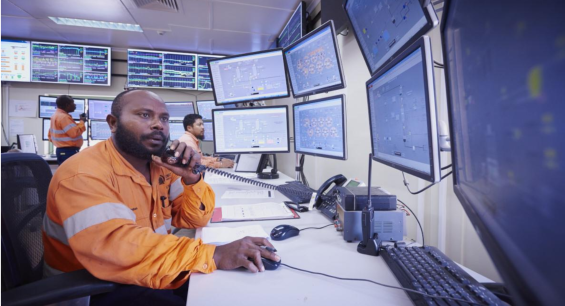As digitisation continues to disrupt the mineral processing space, our Austmine members Ausenco and PETRA Data Science explore the future process plant in operation. The mining industry is moving into the next generation of its existence and both internal and external influences are causing fundamental changes in our operations.
Resources are typically decreasing in grade and are being discovered in more remote and difficult to access locations. Local communities and stakeholders have greater say and more power than ever before. Disruptions to our sector come from unforeseen directions, such as the electronics manufacturing sector who are establishing methods for greater recycling of components.
These factors are putting emphasis on the mining industry to innovate and mining equipment, technology and services (METS) companies have responded with a range of unique technologies and methodologies. This is no more apparent then in the minerals processing space, where digitisation is in full effect and advanced technologies such as machine learning, artificial intelligence and data analytics are being used to assist miners with de-bottlenecking, diagnosing and predicting equipment failure and to continuously improve operations.
One of the key driving forces of innovation in the process plant comes from energy costs and water scarcity pressures.
Greg Lane, Chief Technical Officer at Ausenco has over 30 years’ experience in the field of engineering, design, and operation of minerals processing plants. He believes that social licence to operate and community expectations are driving innovation in plant design and optimisation.
“Mineral processing is linked to two major forces in the current industry environment – social licence to operate and reduction of capital and operating costs. Financial considerations and community acceptance are interlinked. Plants that use water and energy more efficiently and have a smaller physical footprint (and associated lower capital cost) are likely to be more acceptable to the community.” he stated.
“The greatest water and energy consumption in the process plant is associated with the comminution and beneficiation, sometimes integrated with hydrometallurgical processes. As a result, process development and innovation are focussed on reducing energy consumption in comminution and water consumption in beneficiation.”
Lane pointed to a few key areas of innovation within the water and energy usage space that will be fundamental in sustainable mining operations. These are:
•Improved mining methods that deliver a finer feed to the plant comminution circuit at lower cost
•More energy efficient comminution circuits, involving either wet or dry “grinding”
•Coarse particle beneficiation to avoid grinding the mined ore too fine
•More efficient beneficiation equipment and chemistry
•More efficient water and energy recovery
There is no doubt that community expectations and social licence is proving to be a strong catalyst for change in the processing space.
The other major transformational force re-shaping plant operations is digitisation, occurring through high-tech businesses entering the mining industry and traditional suppliers becoming more sophisticated and smarter with their use of technology.
Penny Stewart is the Managing Director of PETRA Data Science, an innovative SME METS company specialising in enabling resources companies to turn their data into actionable insights and operational improvements. Through PETRA’s team of data scientists and engineers, they’re leading the way towards a more productive future for mining.
“Ore variability greatly affects processing plant performance, but until recently it has been very difficult to quantify variability across the whole orebody. Now, with machine learning, we ingest 100s of millions of tonnes of historical data to create digital twin of the whole operation. Using digital twin prediction and simulation we identify opportunities for improvement in scheduling, blasting, blending and process control.” she explained.
For example; digital twin simulation at PanAust’s Ban Houayxai gold-silver operation has the following applications. Ban Houayxai is located in the Lao People’s Democratic Republic and has been in continuous production since 2012. it is an operating asset for PanAust Ltd, an Australian-based copper and gold producer:
•Identified areas that have possible problematic gold recovery
•Optimisation of drill and blast to suit certain rock types
•Ideal mill settings (power draw, motor temperature, noise levels, recirculating load, etcetera) and processed with ideal settings (pH, cyanide levels, reagents, etcetera)
•The MAXTA model, being a digital twin of the operation, effectively provides information for risk analysis, cost improvement studies, analysis and ‘what if’ simulations for various scenarios.
In the picture, Newcrest’s collaboration with PETRA has eliminated mill overloads at Lihir gold mine.
“Being able to see how ore variability plays out in the processing plant is an absolute game changer for mining. And, PETRA is actively collaborating to hone and refine the best ways to productionise the benefits of digital twin simulation across the value chain.
“For example; a Mets Ignited grant is funding integration of MAXTA into Resolution Systems’ Maxmine automated business improvement tool. We are also partnering with UQ’s Julius Kruttschnitt Mineral Research Centre to extend digital twin simulation beyond the historical data using physics based dynamic processing simulation. Upstream, we are working with 3D mine planning software companies such as Maptek to provide access to MAXTA predictions and simulations within normal work flows. As a mining engineer with a penchant for geology, I am particularly excited to see processing plant performance visualisation incorporated into mine scheduling, blasting and blending workflows.”
PETRA has developed a video to show how digital twin visualisation works which you can find here http://www.petradatascience.com/casestudy/worlds-first-digital-twin-for-mine-value-chain-optimisation/
Austmine will continue its exploration of the future process plant in upcoming webinars on 11th September and 25th October on Next Generation Processing and The Optimised Plant in Action. This features industry speakers from Ausenco, PETRA Data Science, Rockwell Automation, Interlate and Process IQ. Find more information at http://www.austmine.com.au/Events











